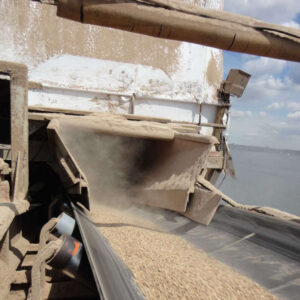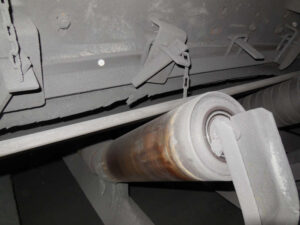Five Leading Reasons and How to Resolve Them
Conveyor chutes are vital to bulk material handling. At the same time, just about every bulk material handler has had to contend with issues related to conveyor chute spillages, such as risks to safety, health, and compliance; slowed production; lost material; and extra housekeeping and maintenance costs.
To correctly manage chute spillage, we first need to understand what causes it. In this discussion, we’ll look at five top reasons for spillage at the transfer chute.
Chute Spillage Reason 1: High-Impact Loading
When free-falling material aggressively loads on a moving belt, it creates impact zone turbulence. More significant changes in flow speed and direction will result in greater turbulence. This turbulent product has not yet established its actual flow density because aeration keeps it lower.
Consequently, the actual load takes on more volume in the load section. In addition, the material expands with force against the skirts with more depth and creates more pressure against the sides. This exerts greater pressure on the skirt sealing, which results in spillage in the chute area.
Chute Spillage Reason 2: Off-Center Loading
 Transfer chutes are made with the goal of a central flow based on a consistent trajectory of a material’s characteristics. However, these characteristics can change during production, and material can build in the chute. This can alter the stream and cause excessive loading on the receiving belt, leading to spillage.
Transfer chutes are made with the goal of a central flow based on a consistent trajectory of a material’s characteristics. However, these characteristics can change during production, and material can build in the chute. This can alter the stream and cause excessive loading on the receiving belt, leading to spillage.
Chute Spillage Reason 3: Poor Material Flow
Because the load zone is a region of constant, intense activity, it creates many conditions that challenge material flow. For example, product fines rise, float, and settle in surrounding areas, such as the bearings and the head pulley. The product also can stick to the sides of the chute. At other times, it may block the transfer chute and cause an overflow. All of this contributes to spillage.
Chute Spillage Reason 4: Poor Receiving Belt Tracking
 Without proper control of conveyor chute spillage, the spilled products can form a crust on the belt idlers and the tail pulley. This can cause the belt to mistrack and lead to even more spillage.
Without proper control of conveyor chute spillage, the spilled products can form a crust on the belt idlers and the tail pulley. This can cause the belt to mistrack and lead to even more spillage.
Chute Spillage Reason 5: Poor Skirting
 Poorly designed skirting seals are the primary source of material leakage at the loading point. Skirting seals’ primary function is to keep dust and particular larger particles from escaping. However, significant head pressure caused by greater demands on the seals will cause them to wear and malfunction, leading to increased spillage near the chute.
Poorly designed skirting seals are the primary source of material leakage at the loading point. Skirting seals’ primary function is to keep dust and particular larger particles from escaping. However, significant head pressure caused by greater demands on the seals will cause them to wear and malfunction, leading to increased spillage near the chute.
Benetech: Total Control of Chute Spillage
As innovative engineers and problem-solvers focused solely on bulk material handling, Benetech knows what you need to remove chute spillage as an obstacle to service and profitability.
Our MaxZone® and MaxZone Plus® systems include the components that resolve the leading causes of spillage we’ve identified.
- Impactful loading solution: The Warrior Impact Bed with a stiff, rigid frame and soft rubber bars cushions and absorbs impact the conveyor belt during loading.
- Off-center loading solution: Adjustable side kicker plates and an adjustable deflector ensure smoother center loading of material onto the loading belt. Removable side panels also allow you to adjust the height according to your load zone requirements.
- Poor material flow, inferior receiving belt tracking solutions: The Warrior Roll & Guide Support Bed includes low-friction slider bars on the wing section and rollers in the center to create a seamless seal against chute spillage. The Simple Slide Idler provides roller frames that slide into place closer together without the need to remove adjacent idlers, even in confined spaces. In addition, primary and secondary belt cleaners clear away troublesome carryback.
- Poor skirting solution: A robust sealing system with no-hassle clamps and seals on the sides of the load zone eliminates spillage. A tail seal with skirting and strip rubber adds a tight seal at the rear of the chute work.
MaxZone components also are affordable and straightforward to install, and they require no welding. The MaxZone Plus system further acts as a modified transfer point chute (not an engineered replacement) that keeps material flowing while significantly reducing spillage.
Take Away Transfer Chute Spillage Starting Today
As a bulk material handler, you don’t need to struggle with spillage as a part of your day. However, you do need reliable ways to ensure more excellent safety, health, compliance, and use of time and capital. Contact us at (630) 844-1300 to speak with a Benetech specialist.
Posted in Conveyor Belts, Flow Control Chutes, and Material Flow
